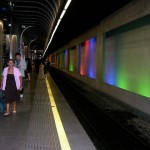Auck Rail Safety Issues
 5 separate platform overrun events on the Auckland suburban rail network raise safety issues in an accident report issued today by the Transport Accident Investigation Commission.
5 separate platform overrun events on the Auckland suburban rail network raise safety issues in an accident report issued today by the Transport Accident Investigation Commission.
Of particular concern was that the inquiry found :
- There was no standardised methodology taught to drivers for braking and other train-handling techniques
- Trains were signed off as being compliant while they technically did not meet the Standard
- Trainer drivers were not taught how to teach trainee drivers
- Trainer drivers were themselves not subject to minimum levels of experience and competency before undertaking trainer duties
- The brake system design was not ideally suited for outer-urban commuter train operations
- One driver reversed his train to the platform without the required authority from train control
As a result two recommendations have been made to the heads of NZTA to address the safety issues related to the standards of driver training and compliance with the National Rail System Standard.
Three recommendations have also been made to the Secretary for Transport about the status of the National Rail System Standard.
All overruns involved push/pull train sets designed and modified in New Zealand from 2003 to cater for the growing needs of the Auckland transport network, pending expansion and modification of the rail infrastructure to cater for new electric train sets within 7 to 9 years. In all cases the trains were being driven in the push mode.
There were no injuries and no damage resulting from any of the 5 incidents. In 4 of the 5 incidents the procedures for dealing with a platform overrun were followed correctly.
In one of the incidents, the driver reversed his train to the platform without the required authority from train control.
The report says that driving technique was a significant factor leading to the platform overruns.
“In particular, there was no standardised methodology taught for braking and other train-handling techniques. Trainer drivers were not taught how to teach trainee drivers and were themselves not subject to minimum levels of experience and competency before undertaking trainer duties.”
The Commission found that the brake system design was not ideally suited for outer-urban commuter train operations, but it was considered fit for the trains’ intended purpose of outer-urban, limited-stop operations that existed in Auckland at the time.
The Commission determined that the National Rail System Standard for passenger train braking distance was not relevant to the design of the network at the time, so the fact that the trains did not comply with that Standard for stopping distance was not in itself a significant safety issue. “However, the fact that the trains were signed off as being compliant while they technically did not meet the Standard was a safety issue that needs addressing by the industry.”
The Commission has also determined that the National Rail System Standard needs to be reviewed to ensure it is consistent with good rail operating practice and is applicable to the New Zealand rail industry, and that the regulator needs to maintain a tight control over the Standard that are currently governed by the industry.
The report referred to a previous report about an empty passenger train that overran a conditional stop without authority, following an automatic air brake valve irregularity at Meadowbank on 6 October 2005.
In that report the Commission commented on the design, performance and maintenance of the brake system on the push/pull fleet. Some of those findings and recommendations were equally applicable to this report.
The report concludes that the operating company’s interpretation of the National Rail System Standard and its decision to test the stopping performance of the push/pull sets based on single-car breakaway tests, rather than as a complete train, resulted in the Standard as written not being complied with.
There was, however, an error within the Standard that had not been detected by either the operating company or the regulator until the trains had been in service for 4 years.
The report makes comments on what level of regulatory oversight should be applied to the design, build and sign off for the push/pull train sets.











0 Comments
You can be the first one to leave a comment.